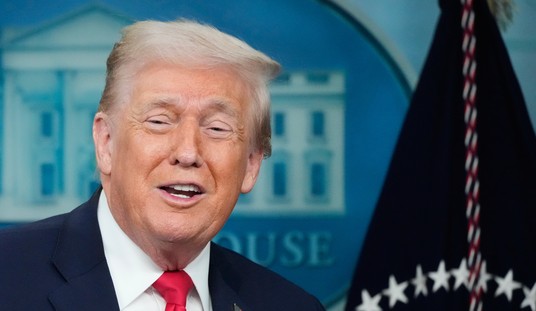The U.S. government practicing Chinese-style censorship against an ally at a democracy summit to avoid angering Beijing feels like the logical culmination of the west’s efforts to engage the CCP.
Reuters has everything you need to know about this except video of the incident itself. Watch a minute or two here of the YouTube upload, and brace yourself for the gut-punch irony of the Taiwanese minister being censored while contrasting the free flow of information in her country with “digital authoritarianism” in China.
Within about 60 seconds the video feed is cut, apparently because the map treats China and Taiwan as distinct political entities. Which of course they are.
U.S. and Taiwanese officials were quick to paper this over afterwards, claiming that the video didn’t drop out because of the map, but Reuters is hearing otherwise from sources.
One source told Reuters the map generated an instant email flurry among U.S. officials and the White House National Security Council (NSC) angrily contacted the State Department, concerned it appeared to show Taiwan as a distinct country.
Washington complained to Taiwan’s government, which in turn was angry that Tang’s video had been cut…
The source called the U.S. move an over-reaction as the map was not inherently about national boundaries, but the NSC was also angry as the slide had not appeared in “dry-run” versions of the presentation before the summit, raising questions as to whether there was intentional messaging by Tang and Taiwan.
A second source directly involved in the summit said the video booth operator acted on White House instructions. “It was clearly policy concerns,” the source said, adding: “This was completely an internal overreaction.”
“They choked,” said one source flatly to Reuters about the White House’s panic. Apparently official U.S. guidelines require that maps used by the federal government denote China and Taiwan with the same color, a nod to America’s “one China” policy, but with the caveat that Taiwan can be pictured as distinct if the context requires it. It did in this case. How is Taiwan supposed to compare the openness of its society to the rest of east Asia without distinguishing China?
The absurdity of this incident gets worse when you remember that the White House invited Taiwan to participate in its democracy summit without extending the same honor to China precisely because it wanted to contrast their respective styles of government. It’s the logical result of the half-pregnant “one China” position in which the White House recognizes the CCP as the legitimate government of mainland China but merely “acknowledges” the CCP’s claim that Taiwan is part of China. That strategic ambiguity led to moral ambiguity in that Taiwan was deemed sufficiently distinct from China to join in a celebration of democracies but not so distinct that a map indicating a difference between it and the mainland could be shown during that celebration. “[I]f you’re afraid to have a Taiwanese representative speaking her mind in a way that might irk the Chinese government — keeping in mind that Taiwanese representatives irk the Chinese government by existing — why are you hosting a much-touted ‘Democracy Summit’?” asked Jim Geraghty, reasonably.
The White House even went as far as to add a disclaimer to the video, “Any opinions expressed by individuals on this panel are those of the individual, and do not necessarily reflect the views of the United States government.”
The half-pregnant nature of the “one China” policy is reflected in Biden’s generally muddled thinking about how confrontational to be with Beijing. Remember that a few months ago he casually asserted that the U.S. has a commitment to defend Taiwan, which the White House hurriedly walked back amid Chinese rhetoric towards Taiwan turning more bellicose. Each house of Congress has passed a bill to ban goods produced by slave labor in Xinjiang but conveniently there’s no effort by Democrats to reconcile those bills so that a compromise product might land on Biden’s desk. They’re stalled in Congress despite wide bipartisan agreement on the justness of the cause:
Want to see how they play games so they can say they support a bill but makes sure it never becomes law?
1.Sit on it for months after the Senate passes it
2.Don’t schedule a vote until media finally starts to ask
3.After it passes hold it in the House so the Senate can’t act https://t.co/heVxu6HQrf
— Marco Rubio (@marcorubio) December 10, 2021
Even Biden’s Olympic boycott is a half-measure. U.S. diplomats won’t attend but U.S. athletes will, a compromise which some members of his own party believe doesn’t go far enough:
.@ChrisMurphyCT on President Biden's diplomatic boycott of the Beijing Olympics:
"I don't think it goes far enough … what they are doing to the Muslim Uyghurs is a genocide and we should treat it as such." pic.twitter.com/1HRPyuZtzy
— Pod Save America (@PodSaveAmerica) December 7, 2021
Biden’s ambivalence is a function of two conflicting realities. American animosity towards China is spiking for various reasons — COVID, the devastation of American industry by Chinese competition, aggression towards democratic outposts like Hong Kong and Taiwan, the horrendous human rights abuses that westerners are slowly growing more aware of. He’ll alienate voters if he looks too weak. But on the other hand, no one wants to fight a new war for Taiwan. We would lose and it would cost us dearly. So Biden muddles on, shaking a fist at China while being careful not to swing it at them. Half measures are the most we can expect.








Join the conversation as a VIP Member